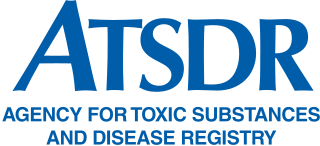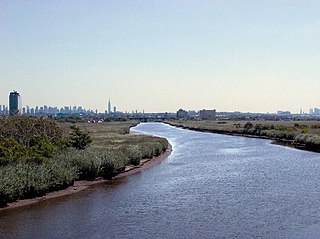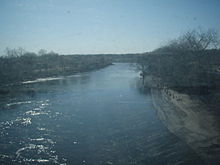
The chemical compound trichloroethylene is a halocarbon commonly used as an industrial solvent. It is a clear, colourless non-flammable liquid with a chloroform-like sweet smell. It should not be confused with the similar 1,1,1-trichloroethane, which is commonly known as chlorothene.

The Agency for Toxic Substances and Disease Registry (ATSDR) is a federal public health agency within the United States Department of Health and Human Services. The agency focuses on minimizing human health risks associated with exposure to hazardous substances. It works closely with other federal, state, and local agencies; tribal governments; local communities; and healthcare providers. Its mission is to "Serve the public through responsive public health actions to promote healthy and safe environments and prevent harmful exposures." ATSDR was created as an advisory, nonregulatory agency by the Superfund legislation and was formally organized in 1985.

Superfund is a United States federal environmental remediation program established by the Comprehensive Environmental Response, Compensation, and Liability Act of 1980 (CERCLA). The program is administered by the Environmental Protection Agency (EPA). The program is designed to investigate and clean up sites contaminated with hazardous substances. Sites managed under this program are referred to as "Superfund" sites. There are 40,000 federal Superfund sites across the country, and approximately 1,300 of those sites have been listed on the National Priorities List (NPL). Sites on the NPL are considered the most highly contaminated and undergo longer-term remedial investigation and remedial action (cleanups).

Berry's Creek is a tributary of the Hackensack River in the New Jersey Meadowlands in Bergen County, New Jersey. The creek watershed contains a diverse array of wetlands, marshes, and wildlife. The creek runs through a densely populated region and has been subject to extensive industrial pollution during the 19th and 20th centuries. Several companies discharged toxic chemicals into the creek in the 20th century, and these chemicals have remained in the sediment. The creek has the highest concentrations of methyl mercury of any fresh-water sediment in the world. Portions of the creek watershed are Superfund sites and cleanup projects began in the late 20th century.

Hexavalent chromium is chromium in any chemical compound that contains the element in the +6 oxidation state. Virtually all chromium ore is processed via hexavalent chromium, specifically the salt sodium dichromate. Hexavalent chromium is key to all materials made from chromium. Approximately 136,000 tonnes of hexavalent chromium were produced in 1985.
The Edison Wetlands Association was founded by noted activist Robert Spiegel in 1989 as a nonprofit environmental organization devoted to the cleanup of hazardous waste sites and the preservation of open space in densely populated central New Jersey.
Imperial Oil is a current Superfund site located off Orchard Place near Route 79 in Morganville, Marlboro Township, Monmouth County, New Jersey. This site is one of 114 Superfund sites in New Jersey. It is in the U.S. Environmental Protection Agency (EPA) Region 2 Superfund area of control and organization. The 15-acre (61,000 m2) Imperial Oil Co./Champion Chemicals site consisted of six production, storage, and maintenance buildings and 56 above-ground storage tanks.
The Omega Chemical Corporation was a refrigerant and solvent recycling company that operated from 1976 to 1991 in Whittier, California. Due to improper waste handling and removal, the soil and groundwater beneath the property became contaminated and the area is now referred to as the Omega Chemical Superfund Site. Cleanup of the site began in 1995 with the removal of hazardous waste receptacles and a multimillion-dollar soil vaporization detoxifying system.
Chromium toxicity refers to any poisonous toxic effect in an organism or cell that results from exposure to specific forms of chromium—especially hexavalent chromium. Hexavalent chromium and its compounds are toxic when inhaled or ingested. Trivalent chromium is a trace mineral that is essential to human nutrition. There is a hypothetical risk of genotoxicity in humans if large amounts of trivalent chromium were somehow able to enter living cells, but normal metabolism and cell function prevent this.

The Koppers Co., Inc. (KCI) Superfund Site is one of three Superfund sites in Oroville, California, along with Louisiana Pacific Sawmill and Western Pacific Railyard. The KCI Superfund Site is a 200-acre site which served as a wood treatment plant for 50 years. Wood was treated with many chemicals to prevent wood deterioration. The accumulation of these chemicals from spills, fires, and uses has caused this site to be contaminated with the hazardous waste material. Due to soil and groundwater contamination, the site was placed on the National Priorities List in 1984 for remedial action plans to clean up the site to protect surrounding residential areas concerning environmental and human health risks.
Kauffman & Minteer Inc. (K&M) was an industrial transportation company that operated from 1960 to 1981 in Burlington County, New Jersey. After cleaning their trucks, they dumped the waste water into a nearby lagoon that was not properly lined. The lagoon flooded and the waste water containing chemicals, migrated over to wetlands, causing damage to vegetation and seeping into underground drinking water. The Environmental Protection Agency (EPA) got involved in 1989 and conducted a few remediation attempts but the extent of the damage is hard to determine as the different underground pathways of water are unpredictable. The site is currently an active superfund site that is closely monitored by the EPA.
The Rockaway Borough Well Field is a Superfund site that came into place in 1981 after the soil was suspected of being contaminated with toxic chemicals. The site is located in Rockaway, Morris County, New Jersey. It was first found to be an official Superfund site after it was discovered that tetrachloroethene (PCE) and trichloroethylene (TCE) were contaminating the soil. Studies suspected that the chemicals were coming from the area of two companies in the town of Rockaway. In 1985, the residents of Rockaway were advised not to drink the tap water and the National Guard had to come and supply water supplies for the community. The town soon installed a water filter system in order to try to reduce the amount of pollution in the water. After finding that the system was not effective, the NJDEP came to the scene to investigate the soil. NJDEP found that the soil tested positive with chemicals and from there the EPA were contacted. The EPA found chemicals in different areas of the borough and found that the soil was contaminated and began to install a groundwater treatment system that functioned to purify the ground of chemicals. The system was soon pumping up to 900,000 gallons of water from the boroughs wells. Today, the pump is still functioning and has since reduced the amount of chemicals and the chance of pollution in the water to appear again. The final project to completely purify the water is still in production.
The A.O. Polymer manufacturing site is located in Sparta Township, New Jersey. This facility created special polymers, plastics, and resins. It was also used for reclaiming spent solvents. The facility's poor waste handling led to serious contamination of the ground. It also contaminated the water in the ground with volatile organic compounds. The site has been a threat to the Allentown aquifer, which provides drinking water to over 5,000 people. Initial clean ups started with getting rid of old drums and contaminants from their original disposal area. The company took them and decided to dispose of them elsewhere, thus not fixing the problem. Primary cleanups of the site were ongoing as of 2008. The EPA has been using water pumps to remove contaminants from the water in the ground. A soil extraction system has been put at their disposal to remove harmful contamination within the soil as well. All wells in the affected areas have been closed.
Emmell's Septic Landfill (ESL) is located at 128 Zurich Ave, Galloway Township, New Jersey and takes up about 38 acres of space. The landfill was in operation from 1967 until 1979. ESL disposed of liquid and solid waste including many chemicals such as volatile organic compounds (VOCs), Polychlorinated Biphenyls (PCBs), Trichloroethene and Vinyl chloride which all had their own effect on the environment and community. These chemicals affected the groundwater required millions of dollars to reconstruct the groundwater pathways and provide clean water to residents. The landfill holds a Hazardous Ranking Score of a 50/100, qualifying for the Superfund National Priority List. In August 1999, the state acknowledged the site's contamination and held town meetings and provided research upon the site such as groundwater samples. In July 1997, a sitewide investigation was called upon by the United States Environmental Protection Agency. In total the clean up was estimated to cost $5 million to fund this superfund site, and a grant of $3.9 million was given by the Federal Government under the Recovery Act Funding (Previti). Today, the project is still ongoing however, greatly improved since the landfill was discovered.
Bog Creek Farm, located in Howell Township, New Jersey, is a designated Environmental Protection Agency (EPA) Superfund site. Lying on 12 acres of land, Bog Creek Farm is home to several hazardous and life-threatening contamination beginning in 1973 and continuing for a year. Over a decade later, actions began to take place to clean and restore the contaminated soil and water. Bog Creek Farm is situated near several other farms that house horses, growing crops and flowers, and livestock. Less than a mile down the road lies Allaire State Park, a park used by golfers, hunters, and fisherman.
The Horseshoe Road Complex Superfund Site in Sayreville, New Jersey is a 12-acre property located near the Raritan River. The industrial site has been out of operation since the early 1980s after a fire revealed 70 drums containing silver cyanide, ethyl acetate, and acetonitrile. The drums caught the attention of the Environmental Protection Agency (EPA) and by 1995 the Horseshoe Road Complex was on the National Priorities List. The site had three areas consisting of the Atlantic Development Corporation (ADC), Horseshoe Road Drum Dump, and Sayreville Pesticide Dump. The neighboring Atlantic Resources Corporation, the location for precious metal recovery, is addressed with the Horseshoe Road Complex (HRC) site due to the intermixing of chemical contamination. The on-site contamination is not an immediate threat to the surrounding community, although prolonged or repeated exposure to the site itself, will result in health effects. The HRC Superfund site is now in its final steps of cleanup in accordance to the EPA's plan.
Brook Industrial Park (BIP) is an industrial area occupying 4.5 acres of the Borough of Bound Brook, New Jersey, in the United States of America. It is located on the northern bank of the Raritan River. Industrial, chemical and pesticide operations began in 1971 and eventually lead to the contamination of groundwater and exposure of workers to harmful dioxins. Throughout 1980 to 1988 the United States Environmental Protection Agency (EPA) and the New Jersey Department of Environmental Protection (NJDEP) conducted studies to determine if there were any threats being posed on the workers, community or environment by the BIP companies in their disposal of processed and stored chemicals.
The Orange Valley Regional Groundwater Superfund site is a group of wells in Orange and West Orange, two municipalities in Essex County, New Jersey, United States. The groundwater in the public wells are contaminated with the hazardous chemicals of Trichloroethylene (TCE), Dichloroethene (DCE), Tetrachloroethylene (Perchloroethene), 1,1-Dichloroethene (1,1-DCE), and 1,2-Dichloroethene (1,2-DCE). These chemicals pose a huge risk to the towns nearby population, as the wells are a source of public drinking water. In March 2012, the site was added to the National Priorities List (NPL) of the United States Environmental Protection Agency (EPA) Superfund site list.
The Pohatcong Valley Groundwater Contamination superfund site is located in Warren County, Franklin Township, Washington Township, and Washington Borough in New Jersey. It was recognized in the 1970s but not designated into the National Priorities List until 1989. It is a contamination of the Kittany Limestone Aquifer underlying the Pohatcong Valley. This toxic site stretches across 9,800 acres of land. The chemicals that are polluting the groundwater and soil are trichloroethylene (TCE) and perchloroethylene (PCE). If someone were to be exposed to these harmful toxins for a short amount of time it can result in unconsciousness. Long term effects unfortunately include liver and kidney problems. The plans to clean up this superfund site are costing the companies involved, Pechiney Public Packaging Inc., Bristol Meyers Squibb Company, Albea Americas Inc, and Citigroup Inc, about $92 million, and the situation still has not been completely resolved.
Adams Plating, also known as Adam's Plating, is a 1-acre (0.40-hectare) Superfund site in Lansing Charter Township near Lansing, Michigan.






